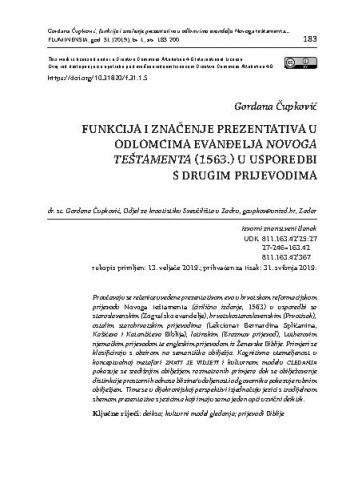Proučavaju se rečenice uvedene prezentativom evo u hrvatskom reformacijskom prijevodu Novoga teštamenta (ćirilično izdanje, 1563) u usporedbi sa staroslavenskim (Zografsko evanđelje), hrvatskostaroslavenskim (Prvotisak), ostalim starohrvatskim prijevodima (Lekcionar Bernardina Splićanina, Kašićeva i Katančićeva Biblija), latinskim (Erazmov prijevod), Lutherovim njemačkim prijevodom te engleskim prijevodom iz Ženevske Biblije. Primjeri se klasificiraju s obzirom na semantička obilježja. Kognitivna utemeljenost u konceptualnoj metafori ZNATI JE VIDJETI i kulturnom modelu GLEDANJA pokazuje se središnjim obilježjem razmatranih primjera dok se obilježavanje distinkcije prostornih odnosa blizine/udaljenosti od govornika pokazuje rubnim obilježjem. Time se u dijakronijskoj perspektivi izjednačuju jezici s trodijelnom shemom prezentativa s jezicima koji imaju samo jedan opći uzvični deiktik.; The paper deals with sentences introduced by the demonstrative evo (“look”) in the Croatian Reformation translation of the New Testament (Cyrillic book from 1563) in comparison with Old Church Slavonic (the Zograf Gospel), Church Slavonic-Croatian (the First printed Croatian Glagolitic mass-book), and with the other Old Croatian translations (Lectionary of Bernardin Splićanin, Kašić’s and Katančić’s Bible), Latin (translation by Erasmus), Luther’s German translation, and the English translation from the Geneva Bible. Examples are classified according to the semantic features. Cognitive grounding in the conceptual metaphor knowing is seeing and in the cultural model of seeing is discussed as a salient feature of the analysed examples, while the marking of the distinction proximal/distal is presented as a marginal feature. In this way, in the diachronic perspective, languages with a three-part system of demonstratives are equated with languages that have only one general interjection in the demonstrative function.
Sažetak

 Fluminensia : časopis za filološka istraživanja : 31,1(2019) / glavni i odgovorni urednik Aleksandar Mijatović.
Fluminensia : časopis za filološka istraživanja : 31,1(2019) / glavni i odgovorni urednik Aleksandar Mijatović.